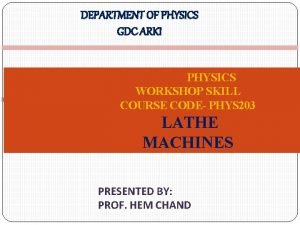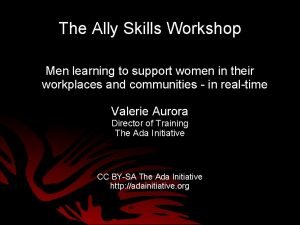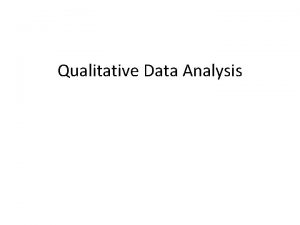Research Skills Workshop Designing a Project Qualitative research











- Slides: 11

Research Skills Workshop Designing a Project Qualitative: research on unique events; action research. Quantitative: effects; quantitative designs (descriptive, experimental); compliance, bias, placebos; sample size for adequate precision; validity and reliability; females and/or males; Willindividual G Hopkinsresponses; mechanisms. Physiology and Physical Education University of Otago, Dunedin, NZ

General · Research is the name for the process of finding out about things, especially the relationship between things. · There are two approaches: qualitative and quantitative. · Use qualitative research to answer "What's happened here? " · Use quantitative research to answer "What's happening generally? "

Qualitative Research · In its purest form, qualitative research is a detailed examination of a single instance or case of something, usually through intensive interviewing or analysis of other evidence. · The quest for truth is similar to that in a court case. · Qualitative paradigms that emphasize subjectivity may be closer to art than science. · Use it to investigate unique events and to explore potentially important factors for a quantitative study. · The open-ended nature of data gathering allows for more flexibility and serendipity in identifying factors and practical strategies than a more structured quantitative approach.

· Action research–a qualitative intervention–can establish causality more convincingly than a purely descriptive qualitative study. · You can use qualitative techniques to study more than one case, but any attempt to generalize from this sample to a population is really quantitative research. · Samples are usually too small, either because few subjects are available, the data gathering is too time consuming, or researchers don't want to be quantitative. · Any study with a small sample can establish only the presence or absence of strong associations in a population. Moderate, weak, or trivial associations remain unclear, because of the uncertainty in the

Quantitative Research · In the simplest quantitative research, the aim is to determine the prevalence, incidence, mean value or other descriptive statistics of something in a population through study of an appropriate sample. · More often the aim is to determine an effect: the relationship between the thing of interest (a dependent or outcome variable, such as performance) and other things (predictor variables, such as training, sex, diet). · The relationship is expressed as an outcome statistic, such as a difference or change in the mean value, a correlation coefficient, or a relative frequency or risk. · You get an estimate the magnitude of the statistic.

· Quantitative research designs are either descriptive (subjects usually measured once) or experimental (subjects measured before and after a treatment or intervention). · A descriptive study establishes only associations between variables. An experiment establishes causality, or lack of it. · Descriptive studies, worst to best: • Case, e. g. a gold medallist. • Case series, e. g. 20 gold medallists. • Cross-sectional (correlational), e. g. sample of 1000 athletes. • Case-control (retrospective), e. g. 200 Olympians and 800 non-Olympians. • Cohort (prospective or longitudinal), e. g. measure characteristics of 1000 athletes then determine

· Experimental studies, worst to best: • No control group (time series), e. g. measure performance before and after a training intervention. • Crossover, e. g. give 5 athletes a drug and another 5 athletes a placebo, measure performance; wait a while to wash out the treatments, then cross over the treatments and measure again. • Controlled trial, e. g. measure performance of 20 athletes before and after a drug and another 20 before and after a placebo (need 4 x as many subjects as in a crossover).

· The estimate of the relationship is less likely to be biased (not the same as in the population) if you have a high participation rate in a sample selected randomly from the population. · In experiments, bias is also less likely if: • subjects are randomly assigned to treatments; • assignment is balanced in respect of any characteristics that might affect the outcome; • subjects and researchers are blind to the identity of the active and control (placebo) treatments. · Sample size is determined by acceptable precision of the estimate, expressed as the likely limits of the true value (95% confidence limits or interval). · To halve the likely range you need 4 x as many subjects.

· Small sample sizes give acceptable accuracy for strong relationships. Therefore you can study batches of subjects until you get acceptable accuracy--sample size "on the fly". · For an accurate estimate of a weak or trivial relationship between variables, a descriptive study usually needs a sample of hundreds or even thousands of subjects; a controlled trial usually needs scores of subjects; a crossover usually needs tens of subjects. · In a descriptive study, the less valid the variable, the bigger the sample size. • Validity--how well the observed value represents the true value--is often hard to determine; retest reliability (reproducibility of the observed value) sets an upper bound on validity and is worth determining in a pilot study.

· In an experiment, the less noisy--more reliable--the variable, the smaller the sample. • Noise is represented by the typical (standard) error of measurement between trials. • A crossover with ~8 subjects gives an outcome with a likely range of ± the typical error. A controlled trial needs ~32. • If you have the time and resources, measure the typical error of the dependent variable(s) in a pilot study with the same time frame as the main study. · Subjects differing in sex, age or other characteristics may differ in the relationship you are investigating. · Therefore include these variables as covariates in the analysis. • = multiple linear regression, analysis of

• But you need bigger samples. For example, to estimate the difference in the effect of sex you will need 4 x as many subjects (e. g. , 40 females and 40 males instead of 20 males). · So, if sample size is a problem, opt for a uniform sample of subjects (e. g. , young females). · In an experiment, try to measure variables that might explain the mechanism of the treatment. · A putative mechanism variable has to at least partly track changes in the dependent variable, but that isn't sufficient to ensure it's a mechanism variable. · Including such variables will increase your chances of publishing in a high-impact journal. · In an unblinded experiment, such variables can help eliminate the possibility of a placebo effect.





















